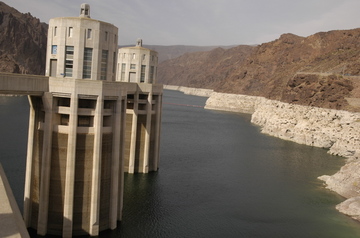Colorado River Water
Emma woke up in the middle of last night with the classic barking cough of croup, and today she has been pretty much knocked flat with a virus. So except for me running out this morning to meet the gas plumbing man at our house-to-be, we've stayed close to the trailer all day, to let her rest.
Even with a full day working on the Fall magazine, this gave me an extra hour or two in the day. Emma was sleeping through the time we'd normally be out at the swimming pool or riding bicycles around the park. I decided to use that time to chase down the rest of the story of water in the southwest. It's more interesting than I had expected, at least to me.
Here's an oversimplified version of the story. California, Arizona, and Nevada don't have enough water, and all three states have overdrawn their natural aquifers in the past century. Southern California in particular is a huge consumer of water, with a large population and huge vegetable farming in the Imperial Valley.
This isn't news. In fact, it was so much of a problem that by 1922 a massive interstate agreement was struck between all of the states that the Colorado River passes through, to divvy up the water. Basically everyone saw that California would suck the river dry if left alone, and so the compact was a way to ensure that didn't happen.
Fast-forward the 1960's. Arizona has an allocation of water from the river but has no ability to make use of it in the population centers. So Arizona finally gets Congress to agree to a $3 billion canal to take water from Lake Havasu to a spot just south of Tucson. This canal is designed to bring Arizona's share of the Colorado River to where it's needed.
Fast-forward to 1993, when the canal (called the "Central Arizona Project") is finally done. The finished canal is 80 feet wide and 336 miles long, and so expensive it will take 50 years to pay off. Here in Tucson, we pay a surcharge of 4 cents per 784 gallons of water, to help pay for it. CAP can deliver up to 2.2 million acre-feet of water each year, which is most of the 2.8 million acre-feet Arizona is entitled to under the 1922 agreement.
Still, in the early 1990s Arizona wasn't using all the river water it was allocated. It was still consuming more underground water than Colorado River water. In the late 1990s the state started "banking" water by recharging the aquifer, like the Avra Valley project I mentioned yesterday, which has two positive effects. First, it helps slow down the draining the aquifer, and second, it gives Arizona the ability to buy and sell water credits. If another state doesn't use all of its annual water allocation, Arizona can store it underground, and give it back later by forgoing part of its share of the river.
This all sounds peachy, but the fact remains that Arizona still uses more water from the underground aquifer than it is putting back in. The "bank" is operating at a loss. In the financial world, this would lead to bankruptcy, and the result with water won't be much different -- unless something changes.
And things will change. I am optimistic. I know that engineers, politicians, and conservationists are endlessly creative. The solutions developed so far have brought the southwestern states much farther than one would have thought possible just a few decades ago. The ticking deadline keeps getting extended through technology, invention, and compromise, driven by necessity. This is why I am not worried about the sky falling while we own a house in Tucson.
In a couple of days Emma will be well again and we will once again go for a swim in the pool. While we're in there, I know I'll be thinking about the water that fills it, and the challenges that must be faced if we are going to keep it full in the decades to come. In a couple of weeks, when we are at the Grand Canyon, and Lake Mead, I'll be reminded of this story again. In the southwest desert, you are never far from the thought of water.

Comments
I came about your blog by chance, looking for cool Airstreamers.... wow, what a great site I found! I went through many of your photos and can only applaud you to take on this long journey. Also, this is THE best thing you can give your child -- homeschooling on the road, how cool is that!! Your photos, of trailers and nature are stunning too; thanks for posting them and making my day! Good luck on your future journey.
Posted by: Bojc | April 11, 2007 05:05 PM